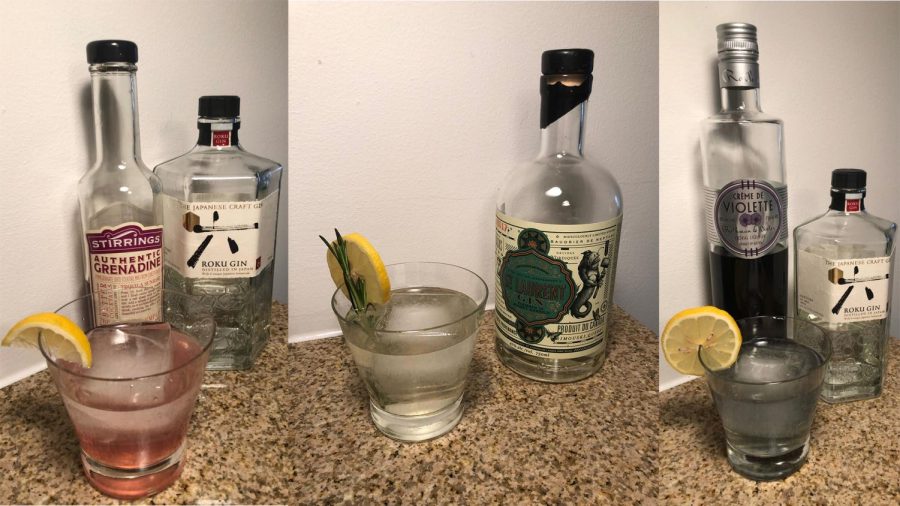Neither shaken nor stirred: A foolproof guide to mastering the gin and tonic
The g&t is a classic cocktail — and the perfect drink for a novice bartender.
While gin and tonics primarily consist of a balanced mix of gin and tonic water, they can be spiced up with citrus, syrups and bitter liqueurs. (Photos by Phoebe Goldman)
January 25, 2022
I feel obligated to tell you: If you’re under 21, read no further. Drinking illegally is a recipe for disaster, and it won’t be too long before you’re able to comfortably — read: legally — walk into a liquor store and buy something nice.
For those of you who are of age, allow me to introduce you to the art of making the gin and tonic, a cocktail that will enhance your palate and impress your friends.
My most important lesson: Call it a “g&t.” You’ll sound extravagant.
There are many variations of the g&t, each with different syrups, liqueurs and whatnot. However, they all contain gin and tonic water, the namesake of this drink.
The cocktail’s origins date back to at least the 19th century, when the British East India Company created a drink to ward off malaria in India. It was mainly ingested by the military, who drank a combination of gin and tonic water, which is carbonated water flavored with the chemical quinine, an antiparasitic that can treat malaria. From there, the tonic water brand Schweppes introduced the “Indian Quinine Tonic,” a drink made specifically for British people to survive while they colonized the Indian subcontinent.
But let’s face it. Chances are if you’re drinking a g&t, you are not drinking it to protect against malaria or colonize other cultures. You’re drinking it because you want to try a sophisticated drink or enhance your flavor profile and try something other than a vodka soda for a change. So let’s get started with the main ingredients: gin and tonic water.
As mentioned earlier, tonic water contains quinine, which is responsible for giving tonic water its uniquely bittersweet taste. Of the many tonic water brands I have sampled, I have to recommend the basic Schweppes. It has a pleasant flavor, balancing between bitter and sweet, and it’s cheap — perfect for a college student on a budget.
In terms of gin — a natural spirit flavored by juniper berries and other herbs — the question gets a bit more complex. If you’re on a budget, use Gordon’s London Dry. It’s pretty terrible, to be honest, but it’s the best you’ll be able to get for under $20.
If you can afford a bit fancier, I recommend either Roku Gin, a Japanese gin that comes in a cool hexagonal bottle, or Uncle Val’s Gin Restorative, which comes in an army green vase. Both of these are light and floral gins, making for a nice g&t.
If you can’t find either of those, don’t be afraid to ask whoever’s stocking shelves at your liquor store. Tell them you want a mid-shelf floral gin, and they’ll connect you with something equally light. No matter what you do, avoid Beefeater at all costs.
Now onto the methodology of mixing the g&t. I aim for about one ounce of gin and three ounces of tonic water, but I’ve heard recipes with ratios of anywhere from a 1-1 to 1-6 ratio. It’s not rocket science; you can eyeball this one.
The easiest thing you can do to spice things up is to grab a lemon and squeeze a bit of juice in there, then cut a wedge and add it to the glass. The acidity will nicely counter the bittersweetness of the tonic water. Just don’t use bottled lemon juice: Lemons are super cheap, squeezing them is easy and the bottled crap tastes way worse.
If you want things a little sweeter, try to get your hands on some grenadine, a fancy word that means pomegranate syrup. You can find Rose’s grenadine at Target or most other grocery stores in the mixers section. Be careful, because this syrup can pack a punch of sweetness; make sure to start off with a plain g&t, then gradually add drops of grenadine until you reach something you like.
If you want to get fancy with it, you can try adding fruit juice. I recommend grapefruit, but there’s no wrong answer here. Start by using as much fruit juice as you use tonic water, then go from there.
Not a fan of citrus or fruit? Then add sweet liqueurs. I’m a big fan of crème de cassis, which is blackcurrant liqueur, but you can’t go wrong with a triple sec either. For the liquor, use a third amount that you would for the gin and continue to add until you reach a drink you enjoy.
Finally, there is Campari, a bitter liqueur flavored with orange peels. It’s an acquired taste, and honestly, I don’t know anyone younger than me who likes it. If you can learn to enjoy it, though, you’ll impress anyone who knows anything about drinks. Like the liqueurs, I’ll add one third as much Campari as gin to a g&t, and it tastes great.
Whether or not you add more expensive liqueurs or leave it with a simple squeeze of lemon, the g&t is the perfect way to start your career as a bartender — not that you or your parents are spending $70,000 a year for that Media, Culture, and Communication degree or anything.
Join me next time as I make spritzes, a refreshing orange colored drink that screams brunch.
Contact Phoebe Goldman at [email protected].
























































































































































